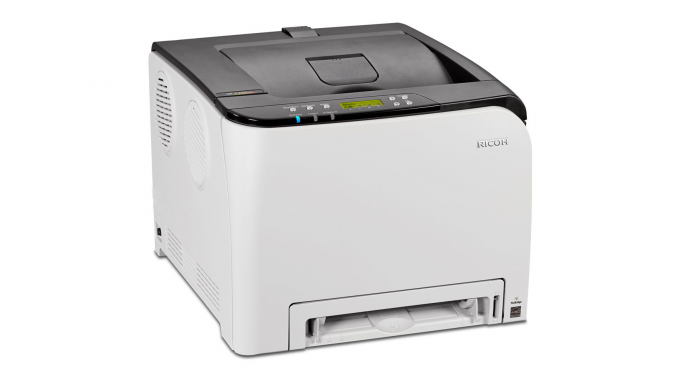Ricoh SP C250dn review - a colour laser printer for just £80
Ricoh's SP C250dn is as cheap as colour laser printers get. Surprisingly, it's not bad at all


While it's not without its niggling flaws, the excellent print quality of Ricoh's SP C250dn makes it easy to recommend. You'll be hard-pressed to find another laser printer that's as cheap as this - let alone one this good.
-
+
Very high print quality; Supremely cheap;
-
-
Surprisingly loud; High running costs;

It's hard to spend less on a colour laser printer than the 80 or so that Ricoh's SP C250dn will set you back. You'd imagine, then, that it might be rubbish, but with both wired and wireless network connections and automatic double-sided (duplex) printing, it looks pretty promising. Its 250-sheet paper tray is enough for most home or micro-office users, and there's a single-page bypass feed for when you need to print on specialty media like an envelope or headed paper.
The SP C250dn isn't the smallest colour laser, and at about 29kg, it's good to have a friend help you unpack it. Despite the bulk, it's a pleasant enough design, with a couple of white panels seemingly wrapped around a black plastic core. There are some nice touches, too, as the vents over its two cooling fans can be rotated to blow hot air to the front or back. It's not perfect, though. While the display is backlit, it's a basic two-line LCD. There are no orientation markings in the main paper tray, which is a pain if you want to print on the flipside of a previous single-sided job.
In use, the SP C250dn was some way off Ricoh's claimed 20-pages-per-minute (ppm) speed. It produced a first page of black text in 23 seconds, and went on to deliver 25 pages at a rate of 16.0ppm. In common with most printers, it was far slower to deal with the complex graphics contained in our 24-page colour test - the whole test completed at 5.8ppm. Timed over just the last 10 pages, which represent printing off typical web pages, it reached 10.5ppm - much faster than a similarly priced inkjet would manage. Duplex printing 10 sides of colour graphics onto five pages took the best part of three minutes, but repeating this with the less complex pages took just 70 seconds.
Happily, print quality was very high. Graphics and photos alike had neutral colours, and the toner gave an even, satin finish. Those with sharper eyes might detect some half-toning patterns among subtly different colours, though, and on thin paper stock I could see some bleed through in duplexed pages. Text quality was exemplary, as you might expect from a laser.
Despite vents which could spare you from an unwelcome draft, this is quite a loud printer - particularly so given its modest speed. While there isn't much clattering from the paper transport mechanism, those fans are loud, and occasionally while they were running I heard a sudden, short-lived buzz, as though an unfortunate insect had just been sucked into the blades.
This is usually the part of a laser printer review where we point out the high running costs, and say you'd be better off with an inkjet. However, while this printer's page costs do work out at a steep 12.6p for a page of mixed text and graphics, that's only about 35% higher than some inkjet MFPs at this price. If you'll be printing in moderate volumes we'd still recommend an inkjet, but for occasional use, this is a cheap printer that's well specified and produces great results - it's an excellent investment.
Verdict
While it's not without its niggling flaws, the excellent print quality of Ricoh's SP C250dn makes it easy to recommend. You'll be hard-pressed to find another laser printer that's as cheap as this - let alone one this good.
Sign up today and you will receive a free copy of our Future Focus 2025 report - the leading guidance on AI, cybersecurity and other IT challenges as per 700+ senior executives
After a brief career in corporate IT, Simon Handby combined his love of technology and writing when he made the move to Computer Shopper magazine. As a technology reviewer he's since tested everything from routers and switches, to smart air fryers and doorbells, and covered technology such as EVs, TVs, solar power and the singularity.
During more than 15 years as Shopper's long-time printer reviewer, Simon tried, tested and wrote up literally hundreds of home, small office and workgroup printers. He continues reviewing smart products and printers for a variety of publications, and has been an IT Pro contributor since 2010. Simon is almost never happier than when surrounded by printers and paper, applying his stopwatch and a seasoned eye to find the best performing, best value products for business users.
-
 ‘1 engineer, 1 month, 1 million lines of code’: Microsoft wants to replace C and C++ code with Rust by 2030 – but a senior engineer insists the company has no plans on using AI to rewrite Windows source code
‘1 engineer, 1 month, 1 million lines of code’: Microsoft wants to replace C and C++ code with Rust by 2030 – but a senior engineer insists the company has no plans on using AI to rewrite Windows source codeNews Windows won’t be rewritten in Rust using AI, according to a senior Microsoft engineer, but the company still has bold plans for embracing the popular programming language
By Ross Kelly Published
-
 Google drops $4.75bn on data center and energy firm Intersect
Google drops $4.75bn on data center and energy firm IntersectNews The investment marks the latest move from Google to boost its infrastructure sustainability credentials
By Nicole Kobie Published
-
 OpenAI says prompt injection attacks are a serious threat for AI browsers – and it’s a problem that’s ‘unlikely to ever be fully solved'
OpenAI says prompt injection attacks are a serious threat for AI browsers – and it’s a problem that’s ‘unlikely to ever be fully solved'News OpenAI details efforts to protect ChatGPT Atlas against prompt injection attacks
By Nicole Kobie Published
